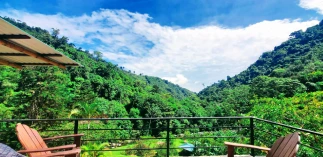High in the Costa Rican mountains, our retreat offers a sanctuary not just for humans seeking peace, but for a vibrant tapestry of birdlife. Today, we turn our binoculars to a delightful little visitor, the Prairie Warbler. While not as common as some of its resident Costa Rican cousins, this sprightly songbird graces our mountain slopes during its winter migration, adding a spark of sunshine with its bright plumage and cheerful song.
A Splendor of Yellow and Olive
The Prairie Warbler, a member of the wood warbler family, is a small bird, typically measuring around 5 inches in length. The males are the real showstoppers, sporting a stunning combination of colors. Their backs are a beautiful olive green, often with subtle reddish streaks, while their chests burst forth in a vibrant yellow. Look closely, and you’ll see dark streaks gracing their flanks, adding a touch of definition. A unique facial pattern completes the picture: a bright yellow line above the eye contrasted by a bold black stripe that runs through it, ending with another splash of yellow below.
Females and Juveniles: A Subtler Beauty
The females and juveniles of the Prairie Warbler don’t quite share the same flamboyant attire as the males. Their plumage is generally duller, with the olive green on their backs lacking the reddish streaks and the yellow on their underparts less intense. However, their beauty lies in their subtlety, and their plumage still offers a delightful harmony of colors.
A Song of Two Flavors
The Prairie Warbler isn’t just a visual treat; it’s also a gifted songbird. These little musicians have two distinct song types, each with its own character. Their “Type A” song is a series of ascending, buzzy notes, perfect for a vibrant morning serenade. In contrast, their “Type B” song is a more subdued affair, featuring a lower pitch and fewer, longer whistled notes often interspersed with some buzzing. Scientists believe these different songs are used in specific contexts, with the A songs used for territorial defense and the B songs for attracting mates.
A Winter Visitor
The Prairie Warbler is a summer resident in the eastern parts of North America, breeding in open habitats like grasslands and shrublands. Come winter, however, they head south, seeking warmer climes. While not as abundant as in other parts of Central America, particularly the Caribbean lowlands, some Prairie Warblers choose the mountain slopes of Costa Rica as their winter retreat. This means that during the colder months in North America, you might just be lucky enough to spot a flash of yellow flitting through the trees at our mountain retreat.
Seeking Out the Prairie Warbler
If you’re keen on adding the Prairie Warbler to your birding list during your stay at our retreat, keep an eye out in shrubby areas, particularly near forest edges. These little insectivores spend their days flitting about, gleaning insects and spiders from the leaves and branches. Their long tails often pump up and down as they forage, making them easier to spot amongst the greenery.
With a bit of patience and a keen eye, you might just be rewarded with a glimpse of this delightful songbird. And who knows, their cheerful melody might just become the soundtrack to your serene mountain escape.
For more information, please view our comprehensive guide about the birds of Costa Rica







